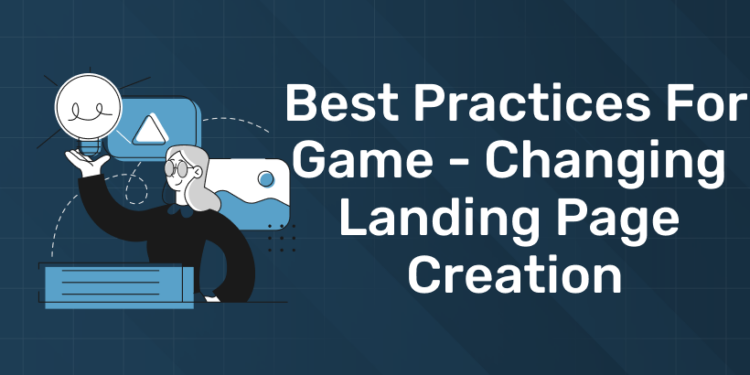Table of Contents
When a potential customer clicks through from an email, advertisement, or other digital location, they may “land” on a standalone webpage known as a landing page. A landing page’s goal is to obtain contact information in return for something valuable, like a retail offer code or business-to-business (B2B) white paper insights. Landing pages are distinct from other web pages in that they are not part of a website’s evergreen navigation. They fulfill a specific function at a specific time during an advertising campaign for a target market. A business’s general overview is typically provided on a website’s homepage. However, a landing page is an effective online marketing tool that can assist you in achieving a particular short-term goal later on in the buyer’s journey. Landing pages are the best way to turn visitors into paying customers because they are made with a specific target audience in mind.
Landing pages are great for digital advertising campaigns, but they can also be helpful when you link a print marketing piece’s QR code to a particular page. A landing page’s primary objective is to convert visitors, making it a vital resource for any kind of marketing campaign.
Discover the Potential of Digital Marketing! Enroll in Entri’s Trial Course Now!
Landing Page: Overview
An independent webpage that a user “lands” on following a click through from an email, advertisement, or other digital source is known as a landing page. Landing pages are an essential component of any content strategy that aims to boost traffic and conversions.
You want visitors to your landing page to take a specific action, like subscribing to your email list or purchasing your merchandise. Your landing page has succeeded in converting the user if they perform the precise desired action.
Landing pages usually only ask visitors to complete a single action, such as completing the page’s personalized signup form. Why?
The “paradox of choice,” as scholars refer to it, is the cause. Put simply, this indicates that people find it more difficult to decide and take action when presented with a large number of options.
Let’s say you are giving away a free ebook. However, you also encourage visitors to your landing page to check out your social media pages, blog, and make a purchase. The likelihood that your users will download your latest ebook decreases with each inquiry since you’ve diverted their focus from your main goal.
On the other hand, an excessive number of options may overwhelm your users and make them hesitate or take no action at all. For this reason, concentrating on just one call to action (CTA) as opposed to three or four is essential.
For this reason, a landing page ought to be optimized for conversions and have a distinct visual hierarchy and value proposition.
Landing Page: Significance
1: What is the primary goal of SEO (Search Engine Optimization)?
Landing pages are distinct from other pages on your website because they are designed to help you achieve particular, short-term objectives. In addition to boosting conversions, enhancing sponsored advertisements, and providing fresh audience data, landing pages can:
Increase your trustworthiness: Consumers usually value concise, straightforward messaging that highlights the benefits of what you’re providing. A thoughtfully designed landing page demonstrates to your clients that you are thinking about their needs. Additionally, as a component of social proof, you can include testimonials about your good or service there. Conversion rates have been found to rise with social proof.
Strengthen your brand: Apply the knowledge you’ve gained. You’ve already worked hard to develop a digital brand. This is the outcome of keeping the look, tone, style, and copy of your website consistent. There are many advantages to having a strong and distinct brand. A strong brand identity can encourage users to respond to your remarketing efforts, remember you in the future, and recommend you to their friends even if they don’t convert right away.
Lead generation: Both kinds of landing pages have the potential to boost sales and produce leads for your company. Because landing pages are more focused, they can concentrate on increasing conversion rates as opposed to providing knowledge and guidance. Alternatively, you can draw attention to the advantages of your goods and services and close more deals with customers who are already interested in what you have to offer.
Boost traffic: Creating a landing page for your website can help you do just that by raising brand awareness and giving potential clients more information about your company, even if lead generation isn’t your primary objective. Your landing pages can target organic traffic in addition to search engine traffic to boost conversion rates.
Landing pages are obviously crucial to your marketing plan. It is preferable to have landing pages that are more optimized. However, that begs the questions of what to optimize them for and how to optimize them.
Become an AI-powered Digital Marketing Expert
Master AI-Driven Digital Marketing: Learn Core Skills and Tools to Lead the Industry!
Explore CourseLanding Page: Steps to Create
Landing Page: Best Practices
Let’s explore these best practices in more detail to help you maximize the effectiveness of your landing pages:
Keep it Simple:
- Think of your landing page as a tranquil oasis amidst a sea of noise.
- A clutter-free, minimalist design not only looks sleek but also ensures that your message and call-to-action (CTA) remain front and center.
- Remove any unnecessary elements that could distract or overwhelm visitors.
- Focus on presenting essential information in a clear and concise manner, guiding visitors towards the desired action without any unnecessary friction.
Maintain Consistency:
- Consistency is key to building trust and credibility with your audience.
- Ensure that the messaging, branding, and visual elements on your landing page align seamlessly with your ad campaigns or promotional materials.
- Consistency reinforces the message that initially attracted visitors to your page, reassuring them that they’re in the right place.
- Whether it’s using the same color scheme, fonts, or tone of voice, maintaining consistency enhances brand recognition and strengthens the overall impact of your messaging.
Leverage Social Proof:
- People are more likely to trust recommendations from others than they are to trust marketing messages from brands.
- Incorporating social proof in the form of testimonials, reviews, and trust badges can help instill confidence in your offer and persuade visitors to take action.
- Highlight positive experiences and endorsements from satisfied customers to showcase the value and credibility of your product or service.
- Social proof acts as a powerful validation mechanism, reducing perceived risk and increasing conversion rates.
Use Scarcity and Urgency:
- Humans are wired to respond to scarcity and urgency—it triggers a fear of missing out (FOMO) and motivates us to take action.
- Creating a sense of urgency by highlighting limited-time offers, low stock availability, or countdown timers can encourage visitors to act quickly rather than procrastinate.
- Whether it’s a flash sale, a time-limited discount, or an exclusive offer, scarcity and urgency tactics can create a sense of excitement and drive conversions.
Optimize Loading Speed:
- In today’s fast-paced digital world, speed is paramount.
- A slow-loading landing page can frustrate visitors and lead to higher bounce rates and lower conversion rates.
- Optimize your page’s loading speed by optimizing images, minimizing scripts, and leveraging browser caching.
- Prioritize content delivery to ensure that essential elements load quickly, providing visitors with a smooth and seamless browsing experience.
- Fast-loading pages not only improve user satisfaction but also contribute to higher search engine rankings and better overall performance.
Implement Tracking and Analytics:
- Data is the lifeblood of effective marketing.
- By installing tracking pixels and setting up analytics tools, you gain valuable insights into visitor behavior, traffic sources, and conversion metrics.
- Monitor key performance indicators (KPIs) such as bounce rate, conversion rate, and average session duration to understand how visitors interact with your landing page.
- Use this data to identify areas for improvement and optimize your page for better results over time.
- Tracking and analytics empower you to make informed decisions and continually refine your approach to maximize the impact of your landing pages.
Discover the Potential of Digital Marketing! Enroll in Entri’s Trial Course Now!
Landing Page: Tips
Ready for some insider tips to supercharge your landing pages? Here are some expert recommendations:
- Use Power Words: Incorporate persuasive words and phrases that evoke emotion and compel action. Words like “free,” “exclusive,” and “limited offer” can grab attention and drive conversions.
- Create a Sense of Trust: Build trust with your audience by showcasing social proof, security certifications, and transparent policies. Assure visitors that their information is safe and that you deliver on your promises.
- Test Different CTAs: Don’t settle for the first CTA you come up with. Experiment with different wording, colors, and placement to see what resonates best with your audience.
- Personalize the Experience: Tailor your landing page content and offers based on the visitor’s demographics, interests, or past interactions with your brand. Personalization can significantly increase engagement and conversions.
- Optimize for SEO: Incorporate relevant keywords and meta tags into your landing page content to improve its visibility in search engine results. This can drive organic traffic and increase your chances of reaching potential customers.
- Offer an Irresistible Incentive: Provide visitors with a compelling reason to take action, such as a discount, free trial, or exclusive content. A tempting incentive can significantly boost conversion rates.
Become an AI-powered Digital Marketing Expert
Master AI-Driven Digital Marketing: Learn Core Skills and Tools to Lead the Industry!
Explore CourseLanding Page: Conclusion
In conclusion, mastering the art of creating high-converting landing pages is a journey that involves continuous refinement and adaptation. By following the steps, best practices, and tips outlined in this guide, you’ve laid a solid foundation for success in your digital marketing endeavors.Crafting effective landing pages isn’t just about designing visually appealing layouts or writing persuasive copy—it’s about understanding your audience, defining clear goals, and optimizing every element to guide visitors towards taking action.
One of the most important takeaways is the importance of testing and iteration. No landing page is perfect from the get-go, and what works for one audience may not necessarily work for another. By conducting A/B tests, analyzing data, and gathering feedback, you can identify what resonates best with your audience and make data-driven decisions to optimize your landing pages for better results. Furthermore, consistency and attention to detail are key. Ensuring that your landing page aligns with your brand identity, messaging, and promotional materials helps build trust and credibility with visitors, reinforcing the message that initially attracted them to your page.
A Note by Entri
At Entri, we’re passionate about helping businesses succeed online.You’ve now equipped yourself with the knowledge and strategies to create high-converting landing pages. Remember, crafting effective landing pages is an ongoing process of testing, learning, and optimization. By following the steps, best practices, and tips outlined in this guide, you’ll be well on your way to driving more leads, sales, and business growth. If you need further assistance with your landing pages or any other aspect of digital marketing, don’t hesitate to reach out to our team of experts. We’re here to support you on your journey to success!
Discover the Potential of Digital Marketing! Enroll in Entri’s Trial Course Now!
Frequently Asked Questions
Q: What is a landing page? A: A landing page is a standalone web page designed with a specific purpose, such as capturing leads or promoting a product or service. It is distinct from other pages on a website and is optimized to encourage visitors to take a particular action, typically through a call-to-action (CTA).
Q: Why are landing pages important? A: Landing pages are crucial for converting website visitors into leads or customers. They provide a focused and tailored experience that guides visitors towards a desired action, such as signing up for a newsletter, making a purchase, or requesting more information.
Q: What are the key elements of an effective landing page? A: Key elements of an effective landing page include a clear headline, compelling copy, eye-catching visuals, a prominent call-to-action (CTA), social proof elements such as testimonials or reviews, and a mobile-responsive design.
Q: How can I create a high-converting landing page? A: To create a high-converting landing page, define your goal, know your audience, craft compelling copy, use persuasive visuals, create a clear call-to-action (CTA), optimize for mobile, and continuously test and iterate based on data-driven insights.
Q: Should I use a template or custom design for my landing page? A: It depends on your resources and needs. Templates can provide a quick and cost-effective solution, while custom designs offer more flexibility and customization options. Choose the option that best aligns with your goals and budget.
Q: How long should a landing page be? A: The length of a landing page depends on its purpose and the complexity of the offer. In general, aim to include enough information to persuade visitors to take action without overwhelming them. Test different lengths to find what works best for your audience.
Q: What are some common mistakes to avoid when creating a landing page? A: Common mistakes to avoid include cluttered design, unclear messaging, weak or buried CTAs, lack of social proof, slow loading times, and insufficient mobile optimization. Addressing these issues can significantly improve the effectiveness of your landing pages.
Q: How can I optimize my landing page for search engines (SEO)? A: To optimize your landing page for SEO, include relevant keywords in your headline, copy, and meta tags. Ensure your page loads quickly, is mobile-friendly, and provides valuable content that aligns with user intent. Building backlinks and promoting your page on social media can also improve its search visibility.
Q: What role does A/B testing play in landing page optimization? A: A/B testing, also known as split testing, involves comparing two versions of a landing page to see which one performs better in terms of conversions. By testing different elements such as headlines, CTAs, visuals, and layouts, you can identify what resonates most with your audience and optimize your page accordingly.
Q: How can I track the performance of my landing page? A: You can track the performance of your landing page using web analytics tools such as Google Analytics. Monitor metrics such as traffic, bounce rate, conversion rate, and average time on page to assess its effectiveness. Set up goal tracking to measure specific actions taken by visitors, such as form submissions or purchases.
Q: What are some best practices for writing compelling copy on a landing page? A: When writing copy for a landing page, focus on the benefits of your offer, use clear and concise language, address potential objections, and incorporate persuasive elements such as urgency and social proof. Make sure your copy aligns with your audience’s needs and motivations.
Q: How can I make my landing page more visually appealing? A: To make your landing page more visually appealing, use high-quality images, videos, and graphics that complement your message and capture attention. Choose a cohesive color scheme and typography, and ensure that the design is clean and easy to navigate.
Q: What are some tips for optimizing the conversion rate of my landing page? A: To optimize the conversion rate of your landing page, focus on improving the clarity of your offer, reducing friction in the conversion process, enhancing trust and credibility, and providing a seamless user experience across devices. Test different elements and strategies to identify what resonates best with your audience and drives more conversions.











